
- Home
- Certification
- Country
- Denomination
- Grade
- Type
- $1 Money-crisp Bills (4)
- Banknotes (1016)
- Collections & Lots (4)
- Error (2)
- Errors (120)
- Federal Reserve Note (75)
- Frn (3)
- Low Serial Number (8)
- Notes (4)
- Novelty (2)
- Perfectladder (2)
- Replacement Notes (95)
- Sequential Numbers (5)
- Silver Certificate (4)
- Silver Certificates (2)
- Star (25)
- Star Note (5)
- Uncut Sheets (48)
- Other (927)
- Year
(5) $100 One Hundred DOLLAR BILLS $500 UNCIRCULATED $100 SEQUENTIAL 2017A
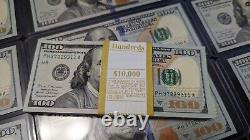
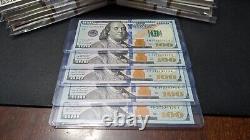
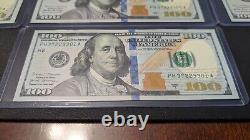

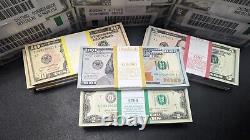
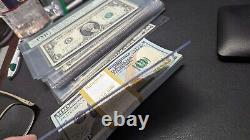


Get these while you can because we have no idea when we will see another strap. And we have only a few lots. Don't see exactly what you want? Just let us know and we can make a special deal that is right for you. Just send us a message. Great for gifts and collectors. You will not be disappointed. We are collectors first and dealers second. From Wikipedia, the free encyclopedia. S portrait by Joseph Duplessis.
With an imbedded image of the Liberty Bell. The first United States Note.
With this value was issued in 1862 and the Federal Reserve Note. Version was first produced in 1914.
Has been featured on the obverse of the bill since 1914. Which now also contains stylized images of the Declaration of Independence. A quill pen, the Syng inkwell. The reverse depicts Independence Hall.
In Philadelphia, which it has featured since 1928. Bill is the largest denomination that has been printed and circulated since July 13, 1969, when the larger denominations.As of December 2018, the average life of a. Is 22.9 years before it is replaced due to wear.
The bills are also commonly referred to as "Bens", "Benjamins", or "Franklins", in reference to the use of Benjamin Franklin. S portrait by the French painter Joseph Duplessis.
On the denomination, as "C-Notes" or "Century Notes", based on the Roman numeral. For 100, or as "blue faces", based on the blue tint of Franklin's face in the current design. The bill is one of two denominations printed today that does not feature a president of the United States. Bill redesign was unveiled on April 21, 2010, and was issued to the public on October 8, 2013. The new bill costs 12.6 cents to produce and has a blue ribbon woven into the center of the currency with "100" and Liberty Bells. Alternating, that appear when the bill is tilted. As of June 30, 2012, the.Bill comprised 77% of all US currency in circulation. Federal Reserve data from 2017 showed that the number of. Bills exceeded the number of.
However, a 2018 research paper by the Federal Reserve Bank of Chicago. Estimated that 80 percent of. Bills were in other countries. Against economic instability that affected other currencies, and use of the bills for criminal activities.
7.4218 × 3.125 in? 1861: Three-year 100-dollar Interest Bearing Notes. Were issued that paid 7.3% interest per year.
These notes were not primarily designed to circulate and were payable to the original purchaser of the dollar bill. The obverse of the note featured a portrait of General Winfield Scott.
Variations of this note were issued that resulted in slightly different wording (obligations) on the reverse; the note was issued again in Series of 1863. 1863: Both one and two and one half year Interest Bearing Notes were issued that paid 5% interest.
The one-year Interest Bearing Notes featured a vignette. In the center, and allegorical. Figures representing "The Guardian" to the right and "Justice" to the left. The two-year notes featured a vignette of the U. In the center, a farmer and mechanic to the left, and sailors firing a cannon to the right.
Were issued with a bald eagle. To the left and large green 100 in the middle of the obverse. The reverse was distinctly printed in orange instead of green like all other U. Federal government issued notes of the time. 1864: Compound Interest Treasury Notes. Were issued that were intended to circulate for three years and paid 6% interest compounded semi-annually. The obverse is similar to the 1863 one-year Interest Bearing Note.Was issued with a portrait of Abraham Lincoln. On the left of the obverse and an allegorical figure representing architecture on the right. Although this note is technically a United States Note. Appeared on it instead of.
Gold Certificate with a portrait of Thomas Hart Benton. On the left side of the obverse was issued. 1870: One hundred dollar National Gold Bank Notes. The obverse featured vignettes of Perry leaving the USS St.And an allegorical figure to the right; the reverse featured a vignette of U. 1875: The reverse of the Series of 1869 United States Note was redesigned. This note was issued again in Series of 1878 and Series of 1880.
Was issued with a portrait of James Monroe. On the left side of the obverse. The reverse was printed in black ink, unlike any other U. 1882: A new and revised. The obverse was partially the same as the Series 1870 gold certificate; the border design, portrait of Thomas H.
And gold-colored ink behind the serial numbers were all retained. The reverse featured a perched bald eagle and the Roman numeral. The note featured a portrait of Admiral David G. The note was also nicknamed a "watermelon note" because of the watermelon-shaped 0's in the large numeral 100 on the reverse; the large numeral 100 was surrounded by an ornate design that occupied almost the entire note. 1891: The reverse of the Series of 1890 Treasury Note was redesigned because the Treasury felt that it was too "busy" which would make it too easy to counterfeit. More open space was incorporated into the new design. 1891: The obverse of the. Silver Certificate was slightly revised with some aspects of the design changed. The reverse was completely redesigned and also began to be printed in green ink. 1902: An extremely rare National Banknote.It had a blue seal, and John J. On the obverse, and two men and an eagle on top of a shield on the reverse. Was issued with a portrait of Benjamin Franklin on the obverse and allegorical figures representing labor, plenty, America, peace, and commerce on the reverse.
1922: The Series of 1880 Gold Certificate was re-issued with an obligation to the right of the bottom-left serial number on the obverse. Gold Certificates were issued with a bald eagle to the left and large green 100 in the middle of the obverse. Legal Tender (1869 version) A new. United States Note was issued with a portrait of Abraham Lincoln on the left of the obverse and an allegorical figure representing architecture on the right. Silver certificate was issued with a portrait of James Monroe on the left side of the obverse. Federal Reserve Note The first. Federal Reserve Note was issued with a portrait of Benjamin Franklin on the obverse and allegorical figures representing labor, plenty, America, peace, and commerce on the reverse. Gold Certificate The Series of 1880 Gold Certificate was re-issued with an obligation to the right of the bottom-left serial number on the obverse.(6.14 × 2.61 in? Both views (obverse and reverse) of the Series 1934. Obverse of a Series 2006A. Portrait of Benjamin Franklin used on the. Bill from series 1928 until series of 1995.
Portrait of an older Benjamin Franklin used on the current. Bill since series of 1996.
Comparison between a Series 1990 note and a 2013 note. 1929: Under the Series of 1928. Currency was changed to its current size. And began to carry a standardized design. Bill would carry the same portrait of Benjamin Franklin, same border design on the obverse.
With a vignette of Independence Hall. Bill was issued as a Federal Reserve Note. With a green seal and serial numbers and as a Gold Certificate.With a golden seal and serial numbers. 1933: As an emergency response to the Great Depression.
This was the only small-sized. Bill that had a slightly different border design on the obverse.
The serial numbers and seal on it were brown. 1934: The redeemable in gold clause was removed from Federal Reserve Notes due to the U. Withdrawing from the gold standard. These notes featured a reverse printed in orange instead of green like all other small-sized notes.The wording on the obverse was also changed to. One hundred dollars in gold payable to the bearer on demand as authorized by law. 1950: Many minor aspects on the obverse of the. Federal Reserve Note were changed. Most noticeably, the treasury seal, gray numeral'100', and the Federal Reserve Seal were now smaller with small "spikes" added around the Federal Reserve seal, like the Treasury seal.
1963: Because dollar bills were no longer redeemable in silver, beginning with Series 1963A. Will pay to the bearer on demand. Was removed from the obverse of the. Federal Reserve Note and the obligation was shortened to its current wording. This note is legal tender for all debts, public and private.
Was added to the reverse. 1966: The first and only small-sized.Was issued with a red seal and serial numbers. It was the first of all United States currency to use the new U. United States Notes, it lacked. On the obverse and featured the motto.
United States Note was issued due to legislation that specified a certain dollar amount of United States Notes that were to remain in circulation. United States Notes were soon to be discontinued, the dollar amount of United States Notes would drop, thus warranting the issuing of this note. United States Notes were last printed in 1969 and last issued in 1971.1990: The first new-age anti-counterfeiting measures were introduced under Series 1990 with microscopic printing around Franklin's portrait and a metallic security strip on the left side of the bill. March 25, 1996: The first major design change of the. Note since 1929 took place with the adoption of a contemporary style layout.
The main intent of the new design was to deter counterfeiting. Which had become more rampant following the rise of computer printing. New security features included a watermark. Of Franklin to the right side of the bill, optically variable ink. (OVI) that changed from green to black when viewed at different angles on the lower right corner'100', an enlarged and different portrait of Franklin, and hard-to-reproduce fine line printing around Franklin's portrait and Independence Hall.Older security features such as interwoven red and blue silk fibers, microprinting, and a plastic security thread which now glows pink [nominally red] under a black light. The individual Federal Reserve Bank Seal with district letter was changed to a unified Federal Reserve System Seal along with an additional prefix letter being added to the serial number, w.
The first of the Series 1996 bills were produced in October 1995. From the San Francisco FRB. From the Western Currency Facility in Fort Worth, Texas.Are produced, almost 16 years after the first notes from the facility were produced. Bill the most recently added production to the facility's lineup.
4.6 billion notes were produced at the facility with series 2006 and Cabral and Paulson signatures, including about 4.15 million star notes. October 8, 2013: The newest. Bill was announced on April 21, 2010, and, because of printing problems, did not enter circulation until nearly three and a half years later, on October 8, 2013. In addition to design changes introduced in 1996, the obverse features the brown quill that was used to sign the Declaration of Independence; faint phrases from the Declaration of Independence; the Syng inkstand. S inkwell; a bell within the inkwell's image that appears and disappears depending on the angle at which the bill is viewed using optically variable ink.(OVI) and changes from copper to green; teal background color; a borderless portrait of Benjamin Franklin; a blue "3D security ribbon" trademarked "Motion" by Crane Currency. On which images of Liberty Bells shift into numerical designations of'100' as the note is tilted; and to the left of Franklin, small yellow 100s whose zeros form the EURion constellation. The reverse features a large gradient'100' printed vertically on the right side, small yellow EURion 100s and has the fine lines removed from around the vignette of Independence Hall. These notes were issued as Series 2009A with Rios. Many of these changes are intended not only to thwart counterfeiting but to also make it easier to quickly check authenticity and help vision-impaired people.
The first of the Series 2009 bills were produced in February 2010. While the Series 2009A replacement banknote was first produced in September 2011.Main article: Large denominations of United States currency. On July 14, 1969, the Federal Reserve announced that the large denominations of United States currency. While the larger denominations remained legal tender. All the Federal Reserve Notes produced from Series 1928 up to before Series 1969 i.
1928, 1928A, 1934, 1934A, 1934B, 1934C, 1934D, 1950, 1950A, 1950B, 1950C, 1950D, 1950E, 1963, 1966, 1966A of the. Since some banknotes had been destroyed, and the population was 200 million at the time, there was less than one. As of June 30, 1969, the U. Coins and banknotes in circulation of all denominations were worth.So the currency and coin circulating within the United States was. Since 1969, the demand for U. The total amount of circulating currency and coin passed one trillion dollars in March 2011. Despite the degradation in the value of the U.
, there are no current plans to re-issue banknotes above. Allison, Assistant to the Board of the Federal Reserve System. In his October 8, 1998 testimony before the U.Subcommittee on Domestic and International Monetary Policy. Committee on Banking and Financial Services. There are public policies against reissuing the.

